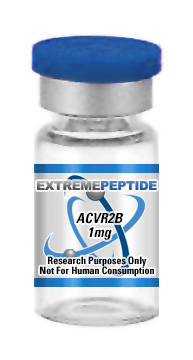ACVR2B is a peptide that has been determined to be an activin type-2 receptor, meaning that it modulates signals for ligands belonging to the transforming growth factor beta superfamily of ligands. It possesses a molecular weight of 57.7239. It can be known by a host of different names, including:
- Activin receptor type-2B
- Activin receptor type IIB
- ACTR-IIB
- ACVR2B
Its appearance when it is administered for purposes of scientific study on animal test subjects is that of a white powder.
Functionality of ACVR2B
According to scientific research that has been conducted on animal test subjects, specific activins such as ACVR2B signal through a heterometric complex of receptor serine kinases that include at least two type I (I and IB) receptors and two type II (II and IIB) receptors. These particular receptors are all transmembrane proteins, and they are composed of a ligand-binding extracellular domain featuring a transmembrane domain, a cysteine-rich region, and a cytoplasmic domain with predicted serine/threonine specificity.
This is important because of the activities that are derived from the receptors themselves. Type I receptors are essential for signaling, whereas type II receptors are needed for binding ligands and for expressing type I receptors. These two types of receptors combine to form a stable complex in the aftermath of ligand binding. This bond results in phosporylation of type I receptors by type II receptors.
Scientific study based on animal test subjects has determined that ACVR2B acts by connecting to proteins that normally signal through a specific activin receptor known as ActRIIB. What’s more, the peptide has been shown to have a capacity to bind to proteins. The most noteworthy of all of the proteins that the peptide has been noted to bind to is myostatin. This particular protein, which is also known as growth differentiation factor 8 or GDF-8, is a secreted growth differentiation factor and member of the TGF beta protein family that blocks muscle differentiation and growth through a process known as myogenesis. It is primarily produced in skeletal muscle cells, circulates in the blood, and acts upon the animal test subject’s muscle tissue by binding an activin type II receptor. This act of binding causes myostatin to regulate and limit the process of muscular growth. Studies have indicated that when this particular peptide binds with proteins such as myostatin, it prevents the proteins from interacting with the ActRIIB receptors. The result of this blockage takes away the regulatory process behind muscular development; this removal of the regulatory process allows the muscles to grow more freely. What’s more, it has been shown that ACVR2B also inhibits the expression of several other proteins that are typically linked to the regulation and control of muscle growth within animal test subjects.
It has been theorized by some scientific study that has been conducted on animal test subjects that due to the fact that myostatin is chiefly produced by skeletal muscle cells, its blockage would in essence trigger the enhancement of glucose metabolism, which would in turn trigger the growth of muscle.
ACVR2B and Muscle Mass
Because of the way in which ACVR2B has been shown to function in conjunction with inhibiting the expression of myostatin, scientific study that has been based on animal test subjects has derived a host of theorized benefits relating to the peptide’s presence.
The chief hypothetical benefit that has been derived from the presence of the peptide is the building up of the mass and size of skeletal muscular tissue. Because it has been determined that ACVR2B blocks the expression of proteins that are chiefly linked to the regulation and control of muscle growth such as myostatin, it is thought that the building of muscle mass and size can occur at a significantly higher rate. This in turn also has led to the determination that an animal test subject that is introduced to the peptide could experience a significantly more efficient sense of muscle strength.
ACVR2B and Weight Loss
It has also been hypothesized by some scientific studies conducted on animal test subjects that ACVR2B could be potentially instrumental in the acceleration of weight loss. Some of these studies have indicated that the peptides capacity to block myostatin, and therefore increase the breakdown of glucose metabolism, would enable the fuel that would be used to provide energy to cellular units would be able to be administered on a cellular level faster. Because of this, it is thought that the acceleration would lessen the chance for adipose tissue (that is, body fat) to develop, thus allowing an increased level of body weight regulation. This theory has also been strengthened by the notion that some scientific study based on animal test subjects has indicated that the blockade of myostatin has led to an increase in lean muscle mass.
Click here to read ACVR2B – Part 2
Click here to view / download PDF
